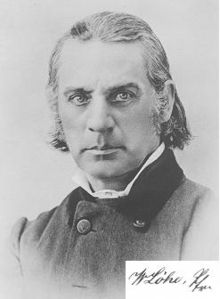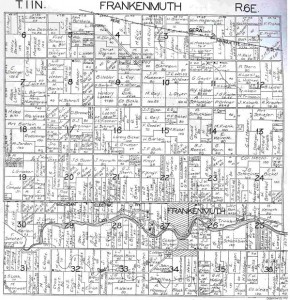St. Lorenz Evangelical Lutheran Church Frankenmuth, Michigan
St. Lorenz Evangelical Lutheran Church was founded in 1845. As part of the larger Lutheran movement, St. Lorenz was founded by European immigrants. St. Lorenz was unique because it was founded by people with diverse interests who shared an intended vocation in spreading the Word of God unlike the majority of immigrants who sought a better life outside of their homeland. Pastor Johann Konrad Wilhelm Loehe was made aware of the writings of Friedrich Wyneken such as Die Noth der deutschen Lutheraner in Nordamerika, written in 1841. By 1844 the group mobilized to be led by an Oxford pastor named Augustus Craemer. Differing from other German immigrant congregations, Pastor Loehe and his Lutheran congregation were from Neuendettelsau in Roman Catholic Bavaria. This factored into forcing many German Lutherans to join together with other reformed groups, another reason behind their pilgrimage to Northern Michigan. When they arrived in Northern Michigan they built a simple community house and a similar church. The group served as both faithful congregation members and active missionaries, soon after their arrival they began to reach out to local Chippewa Tribes in an attempt to Christianize them. Young Chippewa children were living in Pastor Kraemer’s home where he instructed them in the Christian faith soon after his arrival. The next June, almost 100 new German immigrants arrived and joined the budding congregation. In 1846 a larger more permanent church was built and was used until 1880. Throughout its history, education has been key to St. Lorenz and the Lutheran tradition.
Early on the town of Frankenmuth, Michigan was St. Lorenz Church. The exact date of a school being founded is not recorded, however it is reasonable to conclude education was carried out almost entirely via the church. This tradition has clearly had a major impact on modern times as well. The St. Lorenz School enrolls over 500 children each year from kindergarten through 8th grade. In order to put this in perspective, Frankenmuth High School enrolls on average 128 children per grade 9-12. The St. Lorenz School has roughly 62 children per grade K-8th. Among the list of St. Lorenz school alumni that have graduated from Frankenmuth High School includes four Salutatorians and four Valedictorians since 2011. This academic success is a direct product of the German Lutheran ideal of higher education originally proposed by Martin Luther in his Sermon on Keeping Children in School. St. Lorenz’s association is representative of the Lutheran view of the two kingdoms. By having an association with a secular public school and providing a spiritual education until the 8th grade, St. Lorenz educates students in both kingdoms.
St. Lorenz’s position on doctrinal and synodical issues were typical of the mid to late 19th century and continue to be typical of the Lutheran Church-Missouri Synod. They were a founding church of the LC-MS in 1847. The Missouri Synod formalized a coalition of fourteen German Lutheran churches in the United States. It remained a conservative Lutheran group with traditional German Lutheran values. The synod formed many parochial schools as part of their belief in the importance of higher education, of which St. Lorenz is no exception. In 1872 the Missouri Synod met with leaders of the Wisconsin, Illinois, Minnesota, Norwegian and Ohio synods and came to doctrinal conclusions that allowed their merger into the Synodical Conference. The Church remained in the Synodical Conference until 1967 when the Wisconsin Evangelical Lutheran Synod and the Evangelical Lutheran Synod left the conference over the issue of fellowship with other churches. The real dispute however was rooted in doctrinal issues of predestination. Since then the St. Lorenz Church has remained in the Missouri Synod maintaining their traditional and orthodox set of beliefs.
The third sanctuary and current building of St. Lorenz Lutheran Church was designed by Cleveland architect C. H. Greise and built in 1880. By that time 1500 people attended the church. The building features Gothic architecture with ornate decorations, alabaster veneer, and large stained glass windows. The pulpit dates from 1864, coming from the second church building. The altar was built by a local woodcarver in 1895 to celebrate the church’s 50th anniversary. Today, the St. Lorenz congregation exceeds 4900 members.
By Nicholas Swanson
Evan Holmstrom
William Springer
Bibliography













You must be logged in to post a comment.